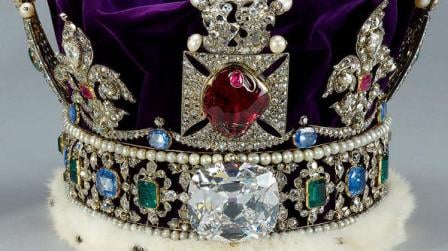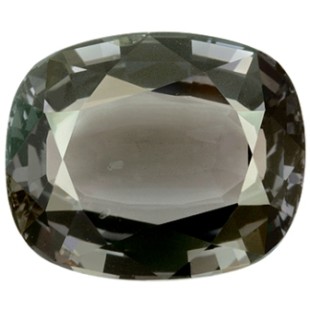
Black Prince’s Ruby in the Imperial State Crown of England
The story of the Black Prince’s Ruby and the Timur Ruby of the Crown Jewels of England both being enormous spinels is not new. The great deception was merely a case of misidentification and misunderstanding. It was always known that the two gems were “balas rubies,” i.e. rubies from Balascia: the ancient Latin name of the ruby mines in the Badakhshan region of what is now Tajikistan.
Badakhshan was known for the better part of a thousand years for its two ruby mines of note – Jagdalek and Gharan – but also for its wonderful spinel mine at Shignan. Even though spinel and ruby were scientifically proven to be different minerals in 1546, the fine red gems from this locality continued to fall under the generalization of Balas rubies for centuries.
But the tale of spinel being mixed up in mix-ups doesn’t end there. Fast forward many centuries during which spinel and ruby become readily differentiated and many misidentified rubies are verified to be spinels, the Black Prince’s Ruby among them in the 1940s.
Via a series of events from 1945-1951, the tables turned on spinel: it was the stepping stone on a course to discover two of the rarest gemstone minerals in the world to date. In 1945, an Irish mineralogist, Count Edward Charles Richard Taaffe (pronounced TARF), discovered a few isolated gemstones in a parcel of faceted mauve spinels from Sri Lanka were doubly refractive – a physical impossibility for spinel, which forms in the cubic crystal system.
Long story made short, it wasn’t until 1951 that these stones were identified as a completely new species of mineral: Taaffeite (pronounced TARF-ITE). This was the first occasion a new mineral species was discovered as an already-faceted gemstone. Since then, several spinels have been confirmed to be Taaffeite. Spinel mistaken for ruby is rarer than ruby. Taaffeite, mistaken for spinel, is, in turn rarer that spinel. Taaffeite is generally regarded as one of the rarest gemstones in the world.

5.03 carat musgravite. Image courtesty of www.musgravite.com.
But that’s still not all. In the Musgrave Ranges of Australia in 1967, a specimen of what was assumed to be a variety of Taaffeite was given greater scrutiny and was determined to be yet another new mineral species that was very, very, VERY similar to Taffeite, yet was distinct. It was so similar to Taaffeite, in fact, that infrared and Raman spectroscopy were the only ways to discern between the two. As cut gems, they can only differentiated by their magnesium content. The mineral was dubbed Musgravite after the location of its discovery, and represents another rare instance of a new mineral being identified from a cut gem.
Where Taaffeite is astronomically rarer than the spinel with which it was found, Musgravite is equally rarer than Taaffeite. While both minerals have been found in at least two locations around the world, gem-quality specimens are exceedingly rare. Taaffeite gems number perhaps a couple hundred at most, but you could probably count on both hands the number of certifiably tested and proven faceted Musgravites in existence…Yes, it’s THAT rare.
Since spinel, Taaffeite, and Musgravite all occur alongside one another, it is plausible that some assumed spinel specimens may be unidentified Taafeite specimens, or some Taaffeite may in fact be Musgravite. Even in a modern age of exacting sciences, simple nuances can – and have – been missed. The stories they lead to are often charming and ironic.
Tags: Black Prince, gemstones, magnesium, minerals, rubies, ruby, spinel, Taaffeite